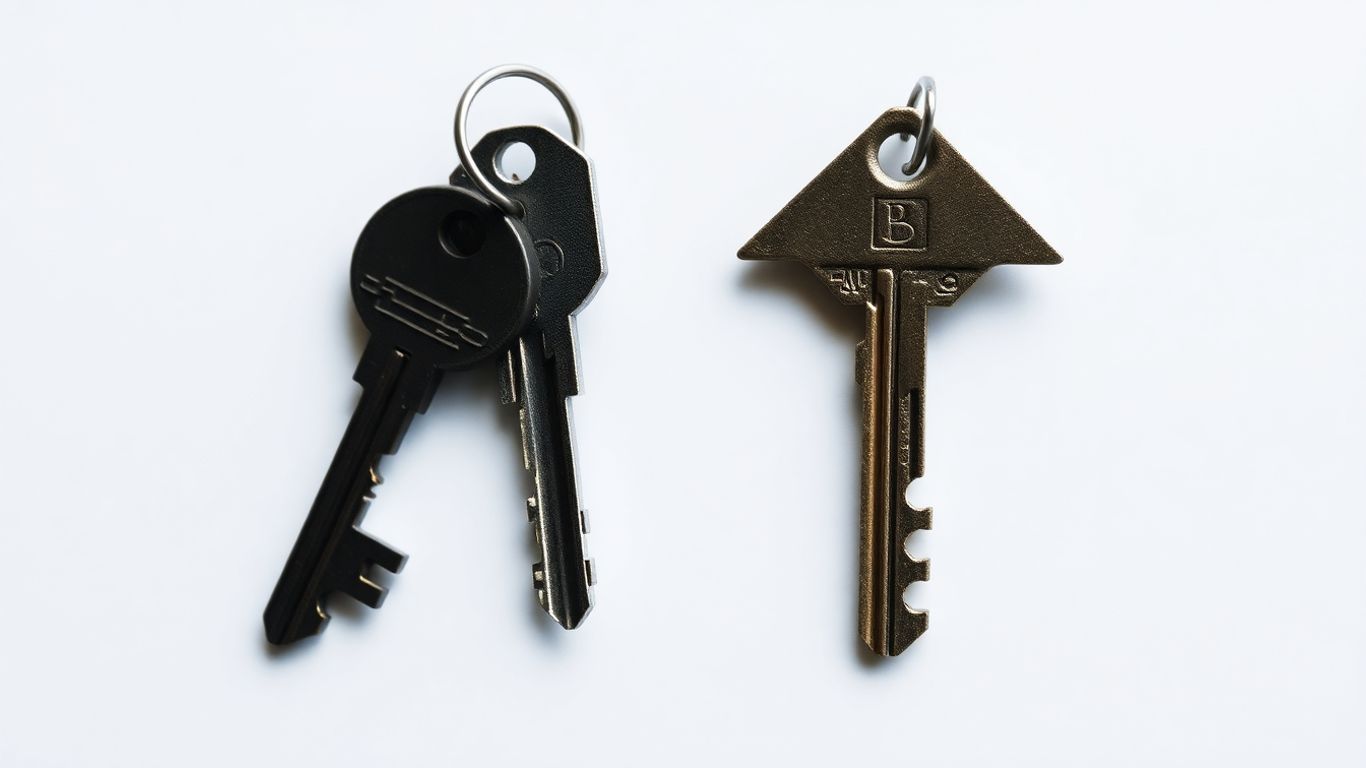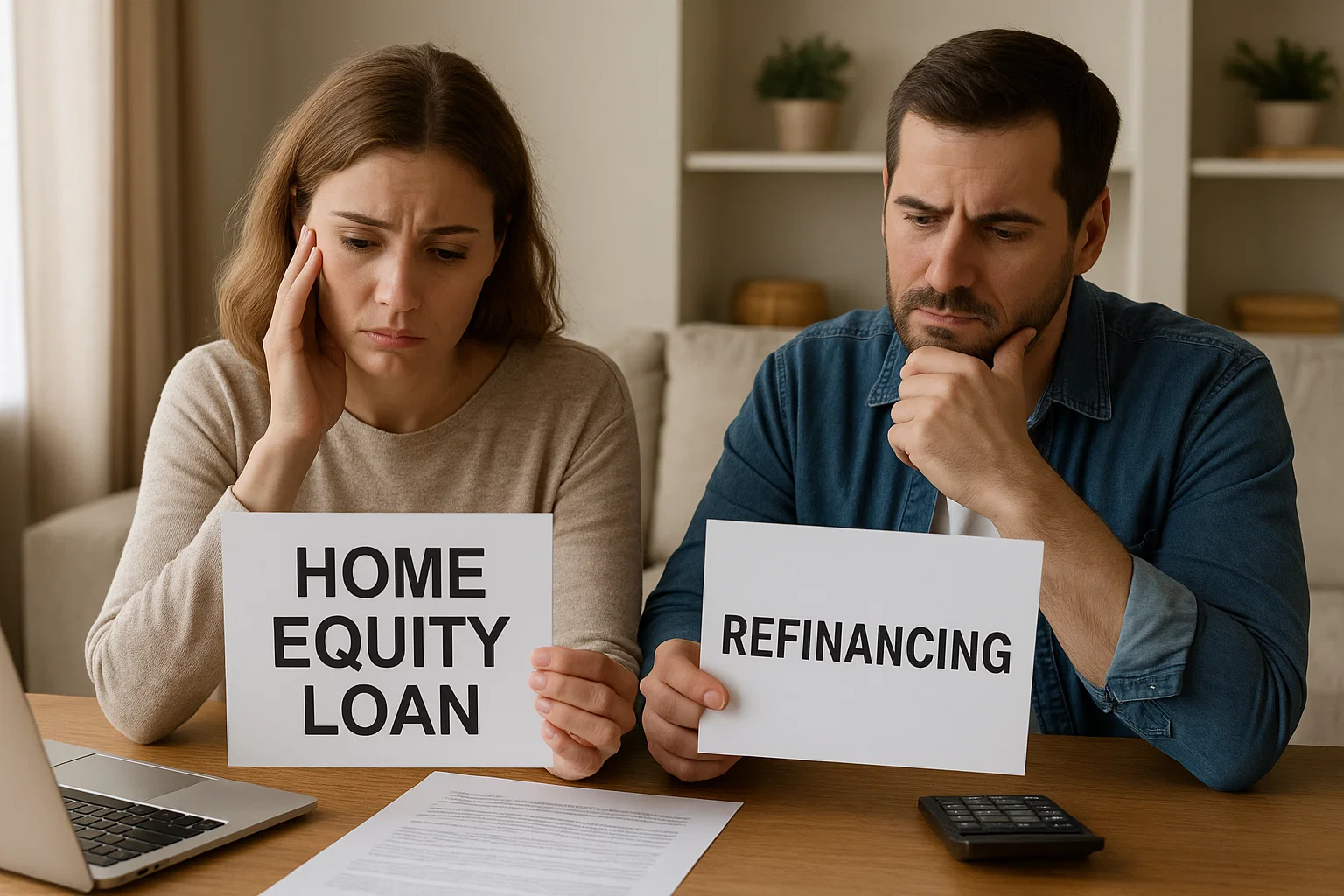Refinance 1st and 2nd Mortgage: Your Complete Guide to Combining Debts
November 19, 2025
Learn how to refinance 1st and 2nd mortgage to combine debts. Our guide covers consolidation, requirements, process, and financial implications.

So, you've got a first mortgage and a second mortgage, and maybe those monthly payments are starting to feel like a bit much. Or perhaps you're just looking to simplify things. Combining them into a single loan, often called mortgage consolidation refinancing, could be the answer. It's like taking two separate bills and turning them into one, hopefully with a better interest rate and a more manageable payment. We're going to break down how you can refinance your first and second mortgage together, what you need to know, and if it's actually a good move for your wallet.
Key Takeaways
- You can combine your first and second mortgage into a single new loan through refinancing, which can simplify payments and potentially lower your interest rate.
- Combining mortgages is possible, but you'll need to meet certain lender requirements, including your home's equity and your creditworthiness.
- Refinancing your main mortgage while keeping a second one might require your second lender to agree to 'resubordination,' which can add complexity and cost.
- Consider the total costs of refinancing, like closing fees, and calculate how long it will take to recoup those costs through savings before deciding.
- It's not always the best idea to consolidate. If you're close to paying off your loans or can't get a better interest rate, it might be better to keep them separate.
Understanding Mortgage Consolidation Refinancing

What is Mortgage Consolidation?
Mortgage consolidation, in simple terms, is when you combine your existing home loans into a single, new mortgage. Most often, this involves merging your primary mortgage (your first mortgage) with any secondary loans you might have, like a home equity loan or a second mortgage. The idea is to replace these multiple payments with just one, which can make managing your finances a lot easier. This process is typically done through a refinance, where you get a new loan that pays off your old ones. Sometimes, people even roll other debts, like credit cards, into this new mortgage, especially if they have a lot of equity in their home.
Benefits of Combining Your Mortgages
Why would someone go through the trouble of refinancing to combine their mortgages? Well, there are a few good reasons:
- Simplified Payments: Instead of juggling two or more mortgage bills each month, you'll have just one. This can really cut down on the mental load and make budgeting feel less complicated.
- Potential Interest Savings: If you can get a lower interest rate on the new, consolidated loan compared to the rates on your existing loans, you could save a significant amount of money over the life of the loan. This is especially true if your second mortgage has a higher interest rate.
- Changing Loan Terms: You might be able to switch from an adjustable-rate mortgage (ARM) to a fixed-rate loan. ARMs can be unpredictable, with payments going up if interest rates rise. A fixed rate offers more stability and predictability in your monthly payments.
- Shorter Loan Term: Sometimes, consolidating can allow you to shorten the repayment period. While this might mean a slightly higher monthly payment, it can save you a lot on total interest paid and get you out of debt faster.
When to Consider Mortgage Consolidation
So, when does it make sense to think about combining your mortgages? It's not always the right move for everyone, but here are some situations where it might be worth exploring:
- Falling Interest Rates: If market interest rates have dropped significantly since you took out your original loans, you might be able to get a lower rate on a new, consolidated mortgage. This is a prime time to consider refinancing.
- High Interest on Second Mortgage: If your second mortgage has a considerably higher interest rate than your first mortgage, consolidating can help you replace that expensive debt with a more affordable one.
- Need for Cash (with Equity): If you have substantial equity in your home and need funds for other purposes (like home improvements or consolidating other high-interest debts), a cash-out refinance to combine your mortgages can provide that liquidity.
It's important to remember that refinancing isn't free. There are closing costs involved, and you need to make sure the savings you expect to achieve will outweigh these upfront expenses over time. Calculating your breakeven point is a key step before deciding to move forward.
Evaluating the Possibility of Refinancing First and Second Mortgages
So, you've got a primary mortgage and a second one, maybe a home equity loan or a HELOC. The big question is, can you actually combine them into one? The short answer is yes, but it's not always a walk in the park. It really depends on a few things, like your financial situation and what the lenders are willing to do.
Can You Refinance Both Loans Together?
Yes, it's definitely possible to refinance both your first and second mortgages at the same time. This is often the most straightforward way to consolidate them into a single, new loan. When this happens, your old first and second mortgages are paid off, and you're left with just one payment. This approach can simplify your finances significantly. However, lenders will look closely at your overall financial picture to make sure you can handle the new, larger loan.
Requirements for Combining Mortgages
To even consider refinancing both loans together, you'll need to meet certain criteria. Lenders want to see that you're a low risk. This usually means:
- A good credit score: Generally, a score of 620 or higher is a good starting point, but higher is always better.
- Sufficient home equity: You need enough equity in your home to cover the combined loan amounts. Lenders often look at the loan-to-value (LTV) ratio, and you'll typically need an LTV of 80% or less.
- Stable income and employment: Lenders need to be confident you can make the payments on your new, larger mortgage.
- Manageable debt-to-income (DTI) ratio: This shows how much of your monthly income goes towards debt payments. A lower DTI is usually preferred.
Combining mortgages means you're essentially taking out a new, larger loan. Lenders will scrutinize your credit history, income, and existing debts to assess your ability to repay. It's not just about having equity; it's about proving you're a reliable borrower.
The Role of Your Second Mortgage Lender
When you refinance your primary mortgage, especially if you want to keep your second mortgage in place, things get a bit more complicated. Your primary mortgage lender has the first claim on your home if you default. If you refinance your primary loan, your second mortgage lender would technically move up to the first position. Most primary lenders won't allow this. They'll require your second mortgage lender to agree to resubordination, which means they agree to go back to being second in line for repayment. This process can involve fees and take time, and not all second mortgage lenders are willing to do it. If they refuse, you might have to pay off the second loan separately or look for a lender willing to refinance both at once. Refinancing a second mortgage on its own is often easier, but combining them requires more coordination. You can explore options for refinancing a second mortgage to see if that's a better fit for your situation.
Navigating the Refinancing Process for Multiple Mortgages

So, you've got two mortgages and you're thinking about rolling them into one. It sounds like a good idea, right? Lower payments, maybe less hassle. But how do you actually do it? It's not quite as simple as just calling up your bank and saying "make it one loan, please." There are a few different paths you can take, and each has its own set of steps and things to watch out for.
Steps to Refinance Your Second Mortgage
Refinancing just your second mortgage, like a home equity loan or a HELOC, is usually the easier route. Since it's already behind your first mortgage in priority, lenders don't get as nervous. Here’s a general idea of what’s involved:
- Check Your Equity: Lenders will look at how much of your home you actually own versus how much you owe. This is your Loan-to-Value (LTV) ratio. Generally, lenders like to see an LTV of 80% or less for a refinance.
- Shop Around: Don't just stick with your current second mortgage lender. Compare rates and terms from different banks and credit unions. You might find a much better deal elsewhere.
- Gather Documents: You'll need proof of income, your credit report, and details about your existing second mortgage.
- Application and Approval: Submit your application and go through the lender's underwriting process. This is where they verify all your information.
- Closing: If approved, you'll sign the new loan documents, and the old second mortgage will be paid off and replaced by the new one.
Refinancing Your Primary Mortgage with a Second Loan
This is where things get a bit more complex. You're looking to refinance your main mortgage, but you want to keep that second mortgage in place. This often involves something called "resubordination."
- Resubordination Explained: When you got your second mortgage, your first mortgage lender agreed to let the second mortgage lender have a claim on your home, but only after they get paid back. If you refinance your first mortgage, the new lender will want to be in the primary position. They'll need to agree to let the existing second mortgage stay in its subordinate position. This process can add time and sometimes cost to your refinance.
- Lender Cooperation: Both your current first mortgage lender and your second mortgage lender need to agree to this arrangement. If either says no, you might not be able to refinance your primary mortgage while keeping the second one as is.
- Potential for Higher Rates: Because the new first mortgage lender is taking on more risk (knowing they're not the only lienholder), they might offer a slightly higher interest rate on the refinanced primary mortgage compared to a situation where there's no second loan.
Working with Mortgage Brokers for Complex Refinances
Dealing with two mortgages can feel like a puzzle. That's where a good mortgage broker can really help.
A mortgage broker acts as an intermediary between you and various lenders. They have access to a wide network of loan products and can often find options that you might not discover on your own. For complex situations like refinancing multiple mortgages, their knowledge of the market and lender requirements can be incredibly beneficial in finding the right fit and potentially saving you money.
Brokers can help you understand:
- Which lenders are most open to refinancing situations involving second mortgages.
- The specific documentation and LTV requirements for your unique scenario.
- How to structure the refinance to get the best possible interest rate and terms.
- Negotiating points and fees, which can significantly impact your total cost.
They essentially do a lot of the legwork for you, comparing offers and guiding you through the process, which can be a lifesaver when you're trying to combine debts. Remember, refinancing takes time, and with two loans involved, it might take even longer than a standard refinance. Be prepared for a potentially longer processing period as lenders dig into your financial details.
Key Considerations When Refinancing
Refinancing your first and second mortgages together sounds like a good idea, right? It can be, but there are definitely some things you need to think about before you jump in. It's not just about getting a lower monthly payment, though that's a big part of it. You've got to look at the whole picture.
Understanding Loan-to-Value Ratios
The Loan-to-Value (LTV) ratio is a big deal when you're refinancing. It's basically a comparison between how much you owe on your mortgage and what your home is actually worth. Lenders use this to figure out how risky lending you money is. If your LTV is too high, meaning you owe a lot compared to your home's value, it can be tough to get approved or you might end up with a higher interest rate. Generally, lenders like to see an LTV of 80% or less for a standard refinance. If it's higher, you might have to pay for Private Mortgage Insurance (PMI), which adds to your costs.
The Impact of Cash-Out Refinances
Sometimes, when you refinance, you can actually pull some of your home's equity out as cash. This is called a cash-out refinance. It can be a way to get funds for a big purchase, home improvements, or to pay off other debts. However, taking out cash means you're borrowing more money, which will increase your loan amount and likely your monthly payments. You also need to make sure you still have enough equity left in your home after taking the cash. It's a trade-off: you get cash now, but you'll pay more interest over the life of the loan.
Weighing the Pros and Cons
So, should you do it? It really depends on your situation. Let's break down some of the main points:
- Potential for Lower Monthly Payments: Combining two loans into one often means a single, potentially lower, monthly payment. This can free up cash flow.
- Simplified Finances: Juggling one mortgage payment is a lot easier than two. No more remembering different due dates or dealing with two lenders.
- Interest Rate Savings: If you can get a lower overall interest rate on the combined loan, you could save a significant amount of money over time.
- Closing Costs: Refinancing isn't free. You'll have to pay closing costs, which can add up. These typically range from 2% to 6% of the loan amount. You need to make sure the savings you get from refinancing outweigh these upfront costs.
- Loan Term Extension: If you refinance into a new loan with a longer term, you might end up paying more interest overall, even if your monthly payment is lower. It's important to look at the total interest paid.
Refinancing closing costs can be a substantial amount, often several thousand dollars. It's important to calculate how long it will take for your monthly savings to cover these costs. If you plan to move before reaching that breakeven point, refinancing might not be financially beneficial for you.
Here's a quick look at how closing costs and savings can play out:
It's a big decision, and you really need to crunch the numbers to see if it makes sense for your specific financial goals.
Financial Implications of Mortgage Consolidation
So, you're thinking about rolling your first and second mortgages into one? That sounds like a good idea, right? It can be, but let's talk about what that actually means for your wallet. It's not just about getting one payment instead of two; it's about the numbers. Understanding the financial side is key before you sign anything.
Calculating Potential Interest Savings
This is often the biggest draw. By combining your loans, you might snag a lower overall interest rate, especially if your second mortgage had a higher rate. Over the life of a loan, even a small difference adds up. Think about it: if you owe $250,000 and can shave off a full percentage point from your interest rate, that's thousands saved. It's worth doing the math to see just how much you could save.
Here’s a look at how interest savings can play out:
Analyzing Monthly Payment Changes
This is where things can get interesting. Sometimes, consolidating can lower your monthly payment. This happens if you get a lower interest rate or extend your loan term. However, be careful here. Lowering your monthly payment might mean paying more interest over the long haul. On the flip side, some people consolidate to pay off their loans faster by choosing a shorter term, like 15 years instead of 30. This usually means a higher monthly payment, but you save a ton on interest.
- Lower Monthly Payment: Great for immediate cash flow, but watch the total interest paid.
- Higher Monthly Payment: Means paying off the loan faster and saving on interest.
- Same Monthly Payment: Might be a good option if you're just looking to simplify and get rid of a second mortgage.
Assessing Closing Costs and Breakeven Points
Refinancing isn't free. There are closing costs involved, just like when you first bought your home. These can include appraisal fees, title insurance, origination fees, and more. You need to figure out how long it will take for your monthly savings to cover these upfront costs. This is called the breakeven point.
You need to stay in your home long enough for the money you save each month to equal the money you spent on closing costs. If you plan to move before you reach that point, you might not actually save any money overall.
For instance, if your closing costs are $6,200 and your monthly payment drops by $350, it will take you about 18 months to break even. If you're thinking about selling your house in the next year or two, that breakeven point is something to really consider. You might want to look into lenders that offer closing cost credits to help offset these expenses.
When Not to Consolidate Your Mortgages
While combining your first and second mortgages into one new loan sounds like a great way to simplify things and potentially save money, it's not always the best move. Sometimes, sticking with your current loans makes more financial sense. Let's look at a few situations where you might want to hold off on consolidating.
Short Remaining Loan Terms
If you're nearing the end of your repayment period on one or both mortgages, consolidating might actually cost you more in the long run. Imagine you've got just two years left on your first mortgage and three on your second. If you refinance these into a new 30-year loan, you're essentially starting all over. That means paying interest for many more years than you would have otherwise. This can add tens of thousands of dollars in extra interest charges over the life of the new, longer loan.
Unfavorable Interest Rates
Consolidation is often about getting a better interest rate. But what if the current market rates are higher than what you're already paying on your existing mortgages? Or maybe your credit score has dipped since you first took out your loans, meaning you won't qualify for a rate that's actually lower than your current ones. In these cases, refinancing would mean paying more interest, not less. It defeats the whole purpose of trying to save money.
Here's a quick way to think about it:
- Your Current Rate: 4.5% on first mortgage, 5.5% on second mortgage.
- Refinance Rate Offered: 6.0%
- Outcome: Consolidating here would increase your interest costs.
Avoiding Additional Mortgage Insurance
Sometimes, when you refinance, especially if you're pulling out cash or your home's value hasn't increased much, your new loan might require Private Mortgage Insurance (PMI). This is typically required if your loan-to-value (LTV) ratio is over 80%. PMI adds a monthly cost, usually between 0.5% and 1% of the loan amount annually. This extra expense can easily eat up any savings you might have gotten from a slightly lower interest rate or payment, making consolidation a bad deal.
It's easy to get caught up in the idea of a single, simpler payment. But always do the math. Look at the total interest paid over the life of the new loan compared to your current loans, factor in all fees, and consider if any new insurance costs will negate your potential savings. Sometimes, the best financial decision is to stick with what you have.
Wrapping It Up
So, combining your first and second mortgage might seem like a lot, but it can really simplify things and save you money. We've gone over how it works, when it makes sense, and what to watch out for, like those closing costs. Remember to crunch the numbers for your own situation before jumping in. It's not for everyone, but for many, it's a smart move to get a handle on your home debts and maybe even lower your monthly bills. Definitely do your homework, compare offers, and make sure it fits your financial picture before you sign anything.
Frequently Asked Questions
What exactly is mortgage consolidation refinancing?
Think of mortgage consolidation refinancing as merging your first and second home loans into a single, new loan. It's a way to simplify things, especially if you have two separate mortgage payments. Sometimes, people even combine other debts, like credit cards, into this new loan, using their home's value as security.
Can I really combine my first and second mortgages into one loan?
Yes, it's definitely possible to refinance both your first and second mortgages together. It often makes sense when interest rates drop, allowing you to potentially get a lower rate on the combined amount. However, you'll need to meet certain requirements, like having enough home equity and a good credit score.
What are the main benefits of combining my mortgages?
The biggest perks are usually a lower monthly payment and saving money on interest over time. Having just one payment to worry about also makes managing your finances much simpler. Plus, if you have a loan with a changing interest rate, you can often switch to a fixed rate, making your payments more predictable.
When should I think about consolidating my mortgages?
It's a good idea to consider this when you can get a significantly lower interest rate than what you're currently paying on both loans. It also makes sense if you want to simplify your finances by having just one mortgage payment. If interest rates have dropped a lot since you got your loans, it's definitely worth looking into.
What happens if I refinance my main mortgage but keep my second mortgage?
This can get a bit tricky. When you refinance your primary mortgage, your second mortgage effectively becomes the 'first' in line if you can't make payments. So, the lender of your second mortgage usually needs to agree to 'resubordinate,' meaning they go back to being second in line. This might involve extra fees and takes time.
Are there situations where consolidating mortgages isn't a good idea?
Absolutely. If you're very close to paying off your existing loans (like only a few years left), consolidating might just extend your payment period and cost you more in interest. Also, if you can't get a lower interest rate than what you already have, or if the new loan requires costly mortgage insurance, it's probably best to skip consolidation.













Get in touch with a loan officer
Our dedicated loan officers are here to guide you through every step of the home buying process, ensuring you find the perfect mortgage solution tailored to your needs.
Options
Exercising Options
Selling
Quarterly estimates
Loans
New home

Stay always updated on insightful articles and guides.
Every Monday, you'll get an article or a guide that will help you be more present, focused and productive in your work and personal life.









.png)
.png)
.png)
.png)
.png)
.png)
.png)
.png)
.png)
.png)
.png)
.png)
.png)
.png)
.png)
.png)
.png)
.png)